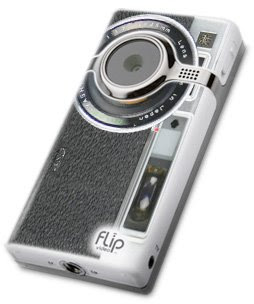It's because they looked like what they are: machines.
Guys love machines.
So here's my tip to camera manufacturers in these recession times (Japan is hit hard): make at camera which looks like a machine.
Make it full metal. No plastic.
Make the screws show.
Lots of levers and dial and things that move.
It will sell, I promise. It does not even have to be a good camera! (Although if it is, you'll also sell to people who know their stuff.)



Stephen Gillette sez:
'Tis true!! We really want dials and doo-hickeys...menus are for kids. I was thinking of buying a Flip Mino a few months back and going the customize route. (Guys like to customize their machines, too.) I designed a façade that had the essence of the old Yashica Electro 35 from the ‘60’s...back in the days when you could whack an assailant with a 35mm camera and he’d need stitches...if he survived!!
Voila:

Thanks for the back-in-time post! I know those machines very well. Shot with the Leica M3s for years, and I own a Nikon F3, and an old F2AS, and a couple of FMs.
ReplyDelete-----------
It's too bad that people these days need totally automatic and intuitive machines to shoot photographs. Depth of field, place of focus, and other techniques and terminology are pretty much lost in this 'modern' age of 127 focus points, face recognition, auto red eye removal, and other crutches for inept photography.
Oh so true! I'll take any one of those machines.
ReplyDeleteInstead of "machine" you could also say "instrument", right?
ReplyDeleteI also like the look of those machines, how they feel when you hold them in your hands and: how they smell!
I still use my old instuments from time to time, pay for batteries and film, just for the fun, or should I say: love of it.
But that's nostalgia, isn't it.
Yet I'm still amazed at what has been done with film, in regard of style, colours, darkroom effects etc.
Nowadays all this can be achieved with your photo programm by clicking on a button. Nothing more, nothing less.
That won't hinder my love for photography, but will extend it even more.
I'm in the habit of leaving comments, but this topic interests me. I shoot digital like everyone else these days, but I'm never without an SLR from the early 70's. The K1000 is still the apex of Japanese engineering.
ReplyDeleteI've never owned a K1000, but I have a ME-Super and a K2. And I do love the compromise-less basic-ness of the K1000. Wonderful cam.
ReplyDeleteReminds me a little of the success of the original Ford Mustang. Bear with me, there is madness in my method I assure you!
ReplyDeleteThe Mustang was cheap enough that a lot of the newly rich late "teenagers" and young men in their early twenties could actually afford one. So far, so peoples car. But the master stroke was the options list. You could doll up your Mustang in all kinds of ways, virtually replacing every original part on the whole car, short of ripping the chassis off and starting again. This was good old fashioned mechanics, the only electricity involved powered the spark plugs, the starter motor and the radio. The thing was that any new part you bought for your Mustang you would normally fit yourself (you may have had a few bucks to buy the part but wouldn't necessarily have had enough to pay someone to fit it - and besides fitting it yourself meant you could get a better, shinier part!) And fitting the part generally involved a bit of gentle persuasion, which meant you felt part of the process, involved. That for me sums up Eolake's desire for cameras to return to being mechanical things, pressing a button that isn't physically connected to the process it initiates is somehow less satisfying.
For the true engineer there is also the joy of taking it apart to see how it works, and then putting it back together again, usually with three screws and a bendy bit of wire left over! And it goes without saying you never, ever read the manual! ;o)